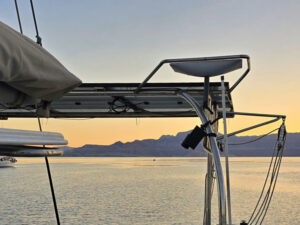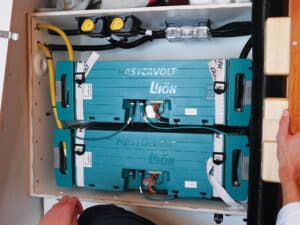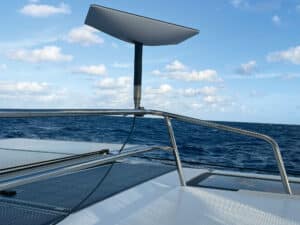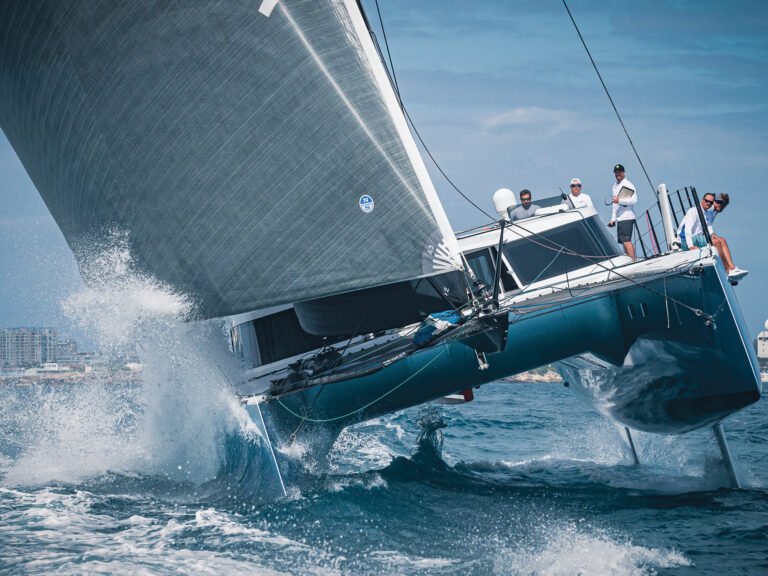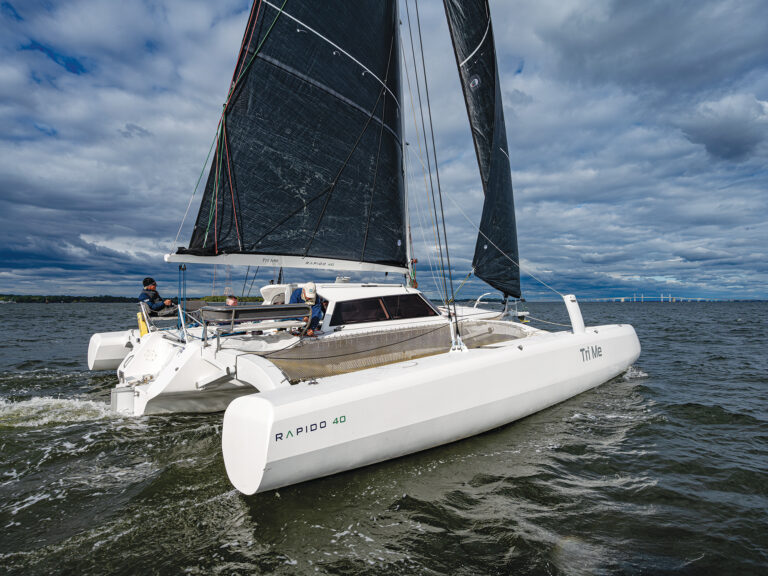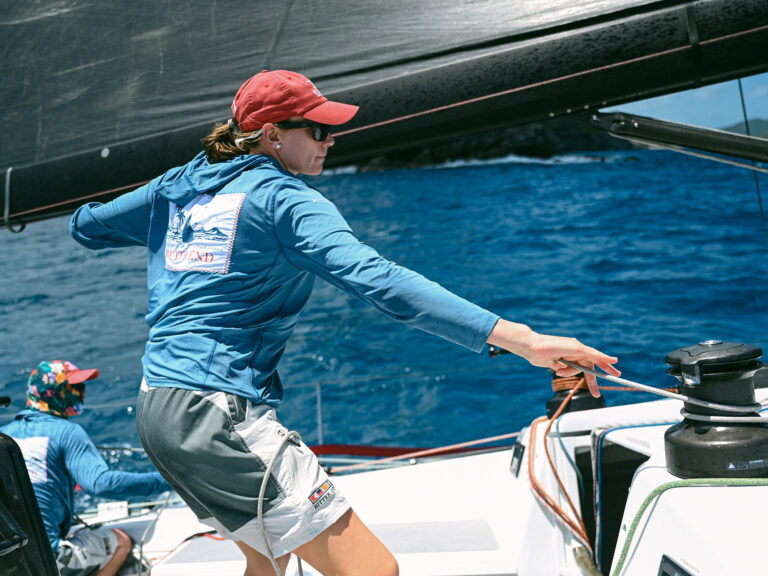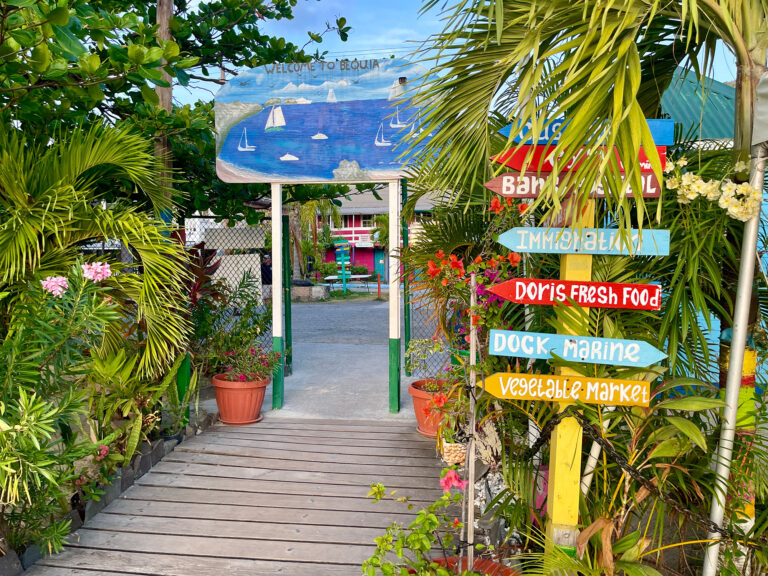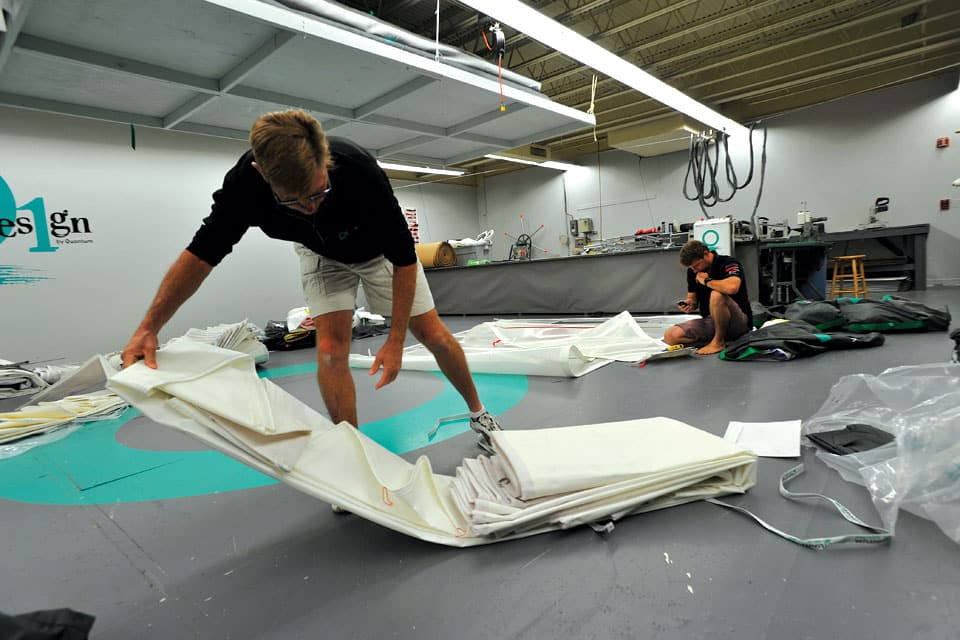
Quantum Sail Design Group
Overview
For both examples I have suggested both a classic “woven polyester” (Dacron) and Fusion MC composite membrane option. Based on the size, hence, the loading differential, the fiber type would change. For the Valiant 40 the Fusion MC 4000 composite would utilize a polyester fiber network. For the Passport 545, The Fusion MC 6500 would use a carbon/technora fiber map. Both woven and composite versions are equally rugged. The Fusion MC composite would offer better initial shape holding and significantly longer shape life. (For a distinction between sail life as a triangle and life as an airfoil, please see attachment “How Long Does a Sail Last”) There are various pre-made materials available to use in “paneled” tri-radial constructions, including Hydranet, Fibercon, Radial Dacron etc. which are not composites that could also be considered. Hydranet, a spectra-reinforced woven material, has been used in this application with success. It makes a durable sail with slightly better performance that has no mildew issues, though typically round the world sailors don’t have mildew issues because the sails are in constant use.
Woven Materials
All top cloth makers (Contender, Bainbridge, Challenge, Dimension) provide various grades of woven polyester, distinguished primarily by their stretch characteristics. The lower the stretch, the more expensive. Typically, each manufacturer refers to their top of the line as HA (high aspect). The only downside to these fabrics is that the same relatively small fibers that allow for a dense weave and low stretch also burn up more quickly in the sun. For extended cruising applications, some additional stretch is the penalty for using slightly larger yarns that maintain their tear strength better over time. All woven sails here are spec’d with Contender Supercruise. Comparable products: Challenge HMW, Bainbridge Ocean Premium, Dimension Heavy. All could be spec’d with HA fabrics if better performance were the primary design criteria.
Composite Materials
Composites for cruising sails have come a long way since first introduced in the mid-eighties. The latest generation of “membrane” style construction effectively eliminates the paneled “jigsaw puzzle” approach with a one-piece integrated fiber network that address sail loadings as a complete whole. Issues of de-lamination have largely been addressed with advances in lamination technique and adhesives. Dramatically better shape life and gains in initial performance are available, particularly as the boat size and loads increase. There are virtually no sails for boats over 65′ that are not of some form of composite construction. This is in and of itself is ample proof of the viability of modern membrane composite construction.
Passport 545
In my mind, this rig setup is where cruising boats are headed. With two headstays one behind the other it allows for a big sail and a small sail to be on tap all the time with the twist of a furling system. The right sails are available with no need to change. The foretriangle is all balanced relative to mainsail area to lessen the need for a big, overlapping genoa. Cruising sailors need to take a cue from racing boats; loose the overlapping headsail! Ease of tacking makes short handed sailing much easier. The P 545 is very flexible in how it can be setup, with an option for a small self-tacking jib on the aft stay, or a larger (but usually non-overlapping) sail led to conventional tracks. Tracks inboard and outboard provide a full range of options to properly sheet the sail on all points of sail. On the outer stay you can opt for a big genoa or a specialized reaching sail (Code Zero). The P 545 also comes in a tall or ICW (intercoastal waterway height). My favorite setup is the tall rig with a maximum size non-overlapping jib on the inner stay, and a Code Zero on the outer stay. Throw in a A2 running asymmetrical for the long downwind legs, and a storm jib (set on a separate removable stay) as insurance against really nasty weather and away you go.
P545 Mainsail
The one question that will come up here is the use of vertical battens. The Selden spar is designed for their use. They will help clean up the leech and minimize the need for leech cord. A very small area increase is practical. The downside is service work. The pockets are a natural point of wear. In a worse case scenario, they can compromise the function of the system, jamming and keeping the sail from rolling properly. In my mind the downside risk is probably not worth the gain. You have already accepted the sail design constraint of an in mast system and you are headed around the world. Keep it simple.
Upwind Headsails
Again, my preference is for a full-size non-overlapping sail for the best combination of ease of handling and performance. An overlapping genoa is only necessary in a light-air area. Go with the self-tacking jib (but make provisions for sheeting to the rail by adding the additional track) for maximum ease of use. The self-tacking jib is small enough that partially furled it will probably not necessitate having a storm jib.
Reaching and Offwind
This is actually where you will spend most of your time with any luck. While a genoa is a better reaching sail than a small jib, a Code Zero is a much better reaching sail. A careful balance between size and shaping, and lighter material, will make this much more useful. Using on a conventional furler makes is totally reliable and easy to use. Most Passport owners tell me this is the sail they use the most. For broad reaches and runs there is not substitute for an asymmetrical spinnaker. With the Code Zero always on tap. I would go for a full size A2 runner, optimized for the broadest angles possible. An ATN spinnaker sock would still be my choice given their long track record, simplicity, and reliability. Top down furlers can also be considered though a full discussion of pros and cons should be had, particularly for a large girth running sail.
Storm Sails
An in-mast furling mainsail pretty much eliminates the need for a storm trysail in my mind. It is easy to make the sail small enough, it has no battens, and not all that dissimilar in size and shape to a trysail when partially furled. In the self-tacking furling jib configuration I think the sail is small enough to work as a storm sail. If using one of the large jib/genoa options, a storm jib set on a separate removable stay makes sense.
Valiant 40
This is the quintessential classic cutter rig, designed in an era when furling systems were just really becoming an option. The rig proportions with a large foretriangle and relatively small mainsail dictate the need for a good size headsail as the primary furling sail. Going to a non-overlapping sail is really not an option unless one is sailing in a very windy place. Ultimately, you would want to have a second, smaller jib for heavy air work and as a backup if the primary sail was damaged. We have done a number of 95-100% working jibs for the Valiant 40. The problem, of course, is changing from big to small. By the time a change is necessary, it is difficult if not impossible for a shorthanded crew. As a classic cutter, the staysail is too small to be this working jib, though is makes a great storm jib.
Mainsail
The conventional mainsail is simple and reliable. Sail size, shape control, structure, and handling should be optimized by the use of full-length battens. I prefer two more deeply spaced slab reefs (15 and 32% of luff length) as opposed to three. The hardware is not there for three. Practically speaking, taking two slightly bigger bites makes more sense. Full length battens demand proper battens and hardware. E glass/ epoxy custom RBS battens are spec’d. Batten luff receptacles are mandatory. A track system like Tides, Antal, Harken, etc. should be strongly considered.
Upwind Headsails
See notes above.
Offwind and Reaching Sails
The big genoa is a pretty code reaching option so a Code Zero is not as important. A Zero could be added on a separate free flying furling system with a torsional rope, but the first sail I would add is an all-purpose (A3) asymmetrical. Since it will have cover a wider range I would not build a full runner (A2), but would go for a slightly reduced girth sail. The foot length needs to be shortened slightly as well (1.7 x J) since the J is so big. If not, the sail will have too low an aspect ratio. Again, an ATN spinnaker sock is my preferred means of handling the sail.
Storm Sails
The staysail covers the storm jib requirement (it is only a few square meters bigger than a SJ). A trysail on a separate masts track could be useful. It would save wear and tear on the mainsail at the very least.
Quantum Sail Design Group

